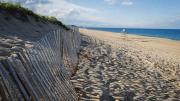Sunscreen, bathing suit, face mask, tape measure. Check. Beaches in and around Boston this year are drawing lines in the sand by restricting activities and, in many cases, reducing access to prevent overcrowding.
All Massachusetts state beaches—whether along the coast or inland lakes and ponds—have reopened (for now), but require face masks and 12-foot spacing between non-related individuals, and limit groups to 10 or fewer people. “Passive” recreation—swimming, walking, sunbathing, and picnicking—is allowed; organized group sports are not. Check out Salisbury Beach State Reservation, and the lakes at Leominster State Forest and Hopkinton State Park or, closer to Boston, Mystic Lakes State Park, in Medford.
On Cape Cod and other coastal spots north and south of Boston, many municipalities, like Manchester-by-the-Sea and Gloucester, have opened beaches and parking lots to residents only, although Wingaersheek Beach offers some non-resident parking spots daily on a first-come, first-served basis.
New Hampshire’s ocean beaches are also open, and authorities have created larger pedestrian zones, through partial road closures and the elimination of parking spots, to accommodate the social-distancing requirements. In contrast to Massachusetts, however, New Hampshire allows only walking, running, swimming, and surfing—no tanning, napping, or picnicking. “This is not a time to drop your blanket and sit around,” according to Governor Chris Sununu: “We want people to be moving.”









